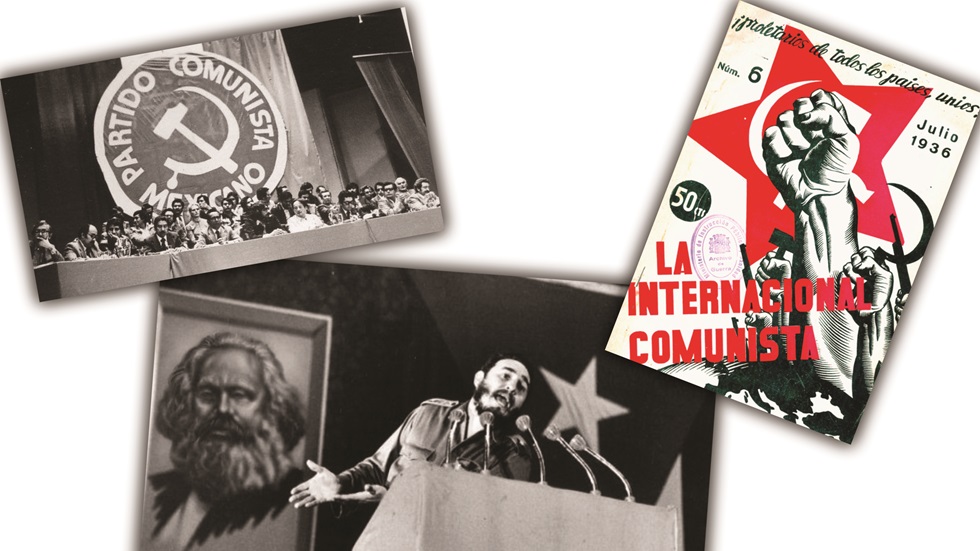
Historical research on communist parties and their multiple international relationships has flourished in the past two decades. One remarkable contribution to this field is the book Transnational Communism Across the Americas. This collection of multiply-authored chapters digs into the communist parties of various Latin American countries, such as Cuba, Puerto Rico, El Salvador, Mexico, and Brazil, providing fresh and in-depth perspectives in most cases.
The topics covered in the book range from regional developments related to the anti-colonial theory of the Communist International to the organization of Black migrant workers in the Caribbean, the involvement of Latin American youth and students in communist-led international organizations during the early Cold War, and the establishment of pro-labor and anti-war activist networks across different regions.
The book is structured into two main chronological parts. The first part, titled “Bolshevism and the Americas (1917-1943),” examines the interactions among the newly established communist parties in Mexico, the U.S., Cuba, Brazil, Panama, Costa Rica, Puerto Rico, and the Communist International.
Formed in 1919 by leaders of various socialist and communist parties in partnership with the Communist Party of the Soviet Union, the Communist International, or Comintern, initially aimed to propagate the socialist revolution initiated in October 1917, support anti-colonial struggles in Asia and Africa, and unify organizers and resources to craft international policies guiding and shaping local struggles.
The leaders, delegates, policymakers, and officials in the Comintern came from many different countries and delivered a complex (sometimes contradictory) political theory about global and local affairs. Comintern congresses, departments, and regional bureaus worked tirelessly to compromise, fuse, and deepen a shared understanding of this theory, especially as it translated to policy. Sometimes, easy solutions to problems or differences of opinion failed to materialize, and complex problems, misunderstandings, and disputes persisted.
The editors and authors of this first part aim to investigate historical archives to understand better the multiple scales of organizing under the Comintern’s leadership at the international, nation-state, and local levels. Immediately, the reader detects an important overall feature in this research: the manifold contradictions that surfaced in the 25 years of the Comintern’s existence.
The Comintern’s headquarters in Moscow, owing to the influence of the Soviet party and the October Revolution, created a power imbalance that favored the established revolutionary organizations over newly formed parties seeking recognition. Its location on the edges of Europe initially ensured its usages of English, French, German, and Russian, which, as several of the authors in this collection note, excluded the Spanish- and Portuguese-speaking countries of the Caribbean, Central, and South America. Thus, as historian Tony Wood notes, it would not be until the latter half of the 1920s that the Comintern “discovered” Latin America.
Authors in the book’s first half study how communist parties in the Americas developed and implemented significant Comintern policies, such as the national question, which by 1928 emphasized the right of self-determination of Black people and Indigenous people in the Americas, with particular attention given to Black people in the U.S., Cuba, and Indigenous nations in Ecuador.
Jacob A. Zumoff shows how this policy explicitly impacted the communist organizing of Black migrant workers in Panama, and Frances Peace Sullivan details how Cuban communists devoted attention to the super-exploitation of primarily Haitian (but also Jamaican and Chinese) migrant workers in the island country’s eastern sugar plantations.
Unfortunately, after discussing the outsized role of U.S.-based Black communists in developing the self-determination thesis, Sullivan characterizes it as “a Soviet take” on local problems. Before she arrives at this conflicting conclusion, she delivers a much more accurate discussion of the national question that historians sometimes fail to elucidate. Sullivan shows that the policy held two equally indispensable sides: It called on communist parties to fight for full equality of Black people in the societies in which they live while advancing the idea that Black people in white-controlled countries (e.g., the U.S., South Africa, Cuba) had the right to choose to form a separate nation-state under their own leadership.
In a related vein, a strangely titled article by Margaret M. Power on the relationship between the Puerto Rican and U.S. communists offers an incongruous analysis. It explores the parties’ transitions in their approaches to public statements about Puerto Rican independence before and during the anti-fascist war. During the war, the two parties emphasized support for the Roosevelt administration’s handling of many economic questions and the anti-fascist war.
At one point, Power attempts to overstate what she believes were both parties’ attempts to walk back their shared call for Puerto Rican independence, even though she quotes leaders from each repeating the demand for it. She seems to believe that their common support for New Deal investments and aid to Puerto Rican infrastructure registers as opposition to independence rather than as a debt owed for nearly a half-century of colonialism.
This bundle of contradictions in her research and analysis further destabilizes her offensive and wildly inaccurate claim that the Puerto Rican communists worked in a subordinate, colonized relationship with the Communist Party USA, a relationship that mirrored U.S. imperialism. Such a conclusion counters the actual evidence referred to in the body of her chapter.
The book’s second part, “Latin American Communism in a Cold War Frame (1945-1989),” presents a more generally reasoned approach. Authors in this section of the book write on subjects such as the World Peace Council’s role in Latin America, communist women’s leadership in their movements, Latin American participation in the World Federation of Democratic Youth (WFDY), and El Salvadoran perspectives on the practical application of the “people’s war” strategy borrowed from the national liberation movement in Vietnam.
The first is a study of the role of Argentinean “cultural diplomat” María Rosa Oliver, which stands out among all the other chapters in the book. Unlike the others, this chapter includes pictures of its main protagonist. More important, the author adopts the unique position, for the most part, of refusing to subject the main character to Cold War frames and tropes. Instead, Oliver’s early role as a radical activist in founding the left-wing journal Sur in 1931, her transition to anti-fascist politics in the 1940s, and her subsequent shift to the anti-imperialism of the peace movement in the 1950s are presented as natural transitions that many committed communists made in those two decades.
Indeed, the author proves that the post-World War II peace movement was not a Soviet cut-out. It was an internationalist movement to prevent a looming World War III and to end Western imperialism and colonialism, sharing an alignment of these goals with (rather than a fabled political submission to) the Soviet Union’s and China’s political objectives.
Perhaps the author escapes the dominant “critical” approaches of some of the other writers by de-linking Oliver from her moorings in the Communist Party of Argentina, referring to her as a “fellow traveler” and not the “typical Stalinist communist.” While this one lapse into an anti-communist trope mirrors many of the familiar anti-communist tropes used throughout much of the rest of the book, its implications are undermined by the vast array of “types” of committed communists that are the subjects within the book as a whole.
None of the authors acknowledge the diversity of personalities, levels of commitment, and complexities of political perspectives (held individually or collectively) despite the actual quoted or paraphrased evidence. And though no individual or even personality traits are ever meaningfully linked to “the typical Stalinist communist,” readers seem to be inundated with the existence of such an idea.
Instead of relying on such Cold War-originated falsehoods, historians might fruitfully benefit from dispensing with such pre-determined stereotypes in their analysis of the evidence.
The reliance on widely used anti-communist tropes in the book Transnational Communism Across the Americas is regrettable and undermines its objectivity. The uncritical reliance on testimonials by former party members who converted to anti-communism perpetuates false narratives about the nature of communist parties and the individuals involved. It befuddles historical facts with obsessions with individuals who talk about “being told what to believe” or the supposed “zigzags” of complex global political dynamics.
The book tends to overstate the power of directives “from Moscow,” creating confusion about the role of the Communist International and the foreign policy of the government of the USSR. Despite these shortcomings, the book offers valuable insights into communist-led struggles, particularly in its second half, for readers who approach it judiciously.
Transnational Communism Across the Americas
Edited by Marc Becker, Margaret M. Power, Tony Wood, and Jacob A. Zumoff
University of Illinois Press, 2023
We hope you appreciated this article. At People’s World, we believe news and information should be free and accessible to all, but we need your help. Our journalism is free of corporate influence and paywalls because we are totally reader-supported. Only you, our readers and supporters, make this possible. If you enjoy reading People’s World and the stories we bring you, please support our work by donating or becoming a monthly sustainer today. Thank you!









